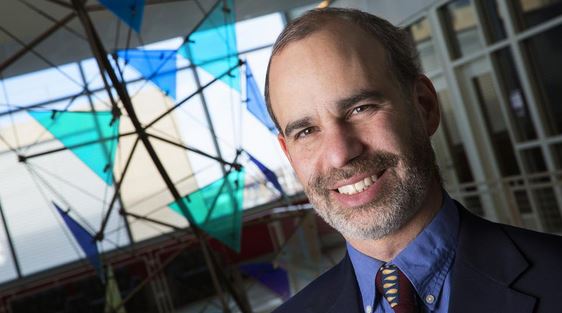
A UNL physicist involved in recreating the immediate aftermath of the Big Bang also played a hand in a recent episode of the CBS show that bears its name.
Ken Bloom, associate professor of physics and astronomy, wrote a blog post that served as a key plot point in the Feb. 5 episode of “The Big Bang Theory.” The complete episode is available here.
The post, which Bloom published on a real blog named Quantum Diaries, discusses a research paper “authored” by central characters Sheldon Cooper and Leonard Hofstadter.
In it, Bloom touts the fictional study as an admirable example of rare collaboration between a theorist and experimentalist. However, the post concludes with a foreshadowing of the episode’s plot: “And Leonard and Sheldon, if you are reading this post – don’t look at the comments. It will only be trouble.”
That trouble comes in the form of negative feedback from a commenter known as GeneralRelativity — later revealed as theoretical physicist Stephen Hawking — whose trolling drives Sheldon and Leonard to defend their research.
Bloom’s involvement with the episode came about by accident. His longtime friend David Saltzberg, the show’s science adviser and a fellow professor of physics at the University of California, Los Angeles, wanted to bolster the plot by mentioning a real physics blog. Saltzberg contacted his colleague about gaining permission to reference Quantum Diaries, which Bloom has written for since 2008.
As one of many international particle physicists who contribute to the blog, Bloom didn’t have the authority to grant that permission. But he did have an idea for the post itself, which was initially conceived as a simple mention in the episode.
“Once I started thinking about it, I said, ‘Why don’t we just write a real blog post on the site, and then there will be something out in the real world?’” Bloom said. “I suggested that to David, who said, ‘Yeah that’s an interesting idea. Let me talk to the producers.’ They liked it, so we ended up doing it.”
Bloom classifies himself as an experimentalist, having contributed to the Large Hadron Collider experiments that accelerated particles to nearly the speed of light at the CERN laboratory in Switzerland. The resulting collisions have simulated conditions of the universe mere nanoseconds after the Big Bang, yielding evidence for the Higgs boson — a particle long theorized to explain how other particles gained their mass.
The pair’s work with physicists who propose such theories, Bloom said, inspired Saltzberg’s conception of the blog post and Bloom’s writing of it.
“Leonard is an experimenter; Sheldon is a theorist,” Bloom said. “The blog post is about how it’s really very unusual for experimentalists and theorists to collaborate, and how they come from very different worlds. But (in this fictional universe), here’s this very interesting example in this paper I came across from these two young guys at Caltech.”
Bloom said he’s seen only a few episodes of the series, which has become one of network television’s most-watched comedies during its eight seasons on the air.
“I don’t really watch any TV,” Bloom said. “No disrespect to television – I just don’t have the time. I knew roughly who the characters were, but I did double-check everything to make sure I had the names right.”
To read Bloom’s blog post, click here: http://www.quantumdiaries.org/2015/02/05/theory-and-experiment-come-together-bazinga
written by Scott Schrage, University Communications